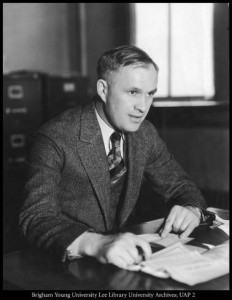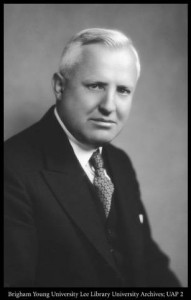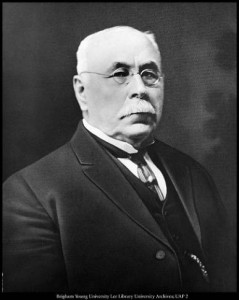Ever wonder where some buildings on campus got their names? Most of us know who the George Albert Smith Fieldhouse, the Joseph Smith Building and the Gordon B. Hinckley Alumni and Visitors Center were named after, but what about the Roland A. Crabtree building or the W.W. Clyde Building?
Pick up The Universe every day this week for a look into how some BYU buildings got their names.
Herald R. Clark Building:

Named out of gratitude to Herald R. Clark, dean of the College of Commerce from 1932 to 1951. For many years he was the driving force in raising money for various campus projects and bringing prominent cultural figures to campus.
Dedicated: 1952
The Herald R. Clark building was originally built to house the BYU Bookstore, student government offices and publications offices. After the bookstore moved to the then-new Ernest L. Wilkinson Center in 1964, the Division of Continuing Education and some of the Media Services offices used the extensively remodeled building.
The Herald R. Clark Building currently houses the David M. Kennedy Center for International Studies, as well as the International Study Programs. The center is the focal point for the study and research of international affairs at BYU, coordinating a multidisciplinary curriculum that draws upon many campus departments and faculty.
Roland A. Crabtree Technology Building:
Named after Roland A. Crabtree, who was a major donor to the school. His donations funded the Crabtree Technology Building, which was completed after his death. At the dedication ceremony, President Boyd K. Packer said Crabtree was the “salt of the earth” and that he loved him even though he had never met him because of his example of humility and selflessness.
Dedicated: 1985
The Crabtree Technology Building currently houses the School of Technology, the Mechanical Engineering Department and the Advanced Combustion Engineering Research Center (ACERC), as well as offices, classrooms, laboratories and a large study area.
Franklin S. Harris Fine Arts Center (HFAC):

Named after Franklin Stewart Harris (Aug. 29, 1884–April 18, 1960), who was president of BYU from 1921 until 1945.
Dedicated: 1964
The Harris Fine Arts Center is the main location for the College of Fine Arts and Communications, housing most of the college’s departments and divisions. It consists of several named areas, as well as an added collection of study rooms, small painting studios, theater work rooms, classrooms and faculty offices. The HFAC was designed by architect William Pereira.
Jesse Knight Building (JKB):
Named after Jesse Knight (Sept. 6, 1845 — March 14, 1921), who was one of relatively few LDS mining magnates in 19th century Western America. He helped save the LDS Church financially after it incurred debt from legal battles with the federal government over control of the Utah territory and other federal issues.
Dedicated: 1960

The building was first occupied by the BYU Commercial College and housed most business classes. It was significantly expanded in 1966, and eventually became the College of Humanities’ headquarters. With the completion of the new Joseph F. Smith building in 2005, some humanities functions were shifted out of the Jesse knight Building, and some non-humanities institutions have since moved into the building, so it is no longer known as the Jesse Knight Humanities Building (JKHB) as it was for many years.
Currently the Jesse Knight building houses the University Police Department, Freshman Academy administration, Human Resource Development, the Visual Arts department, the English Writing Center, the Humanities Publications Center, School of Management computer laboratories and a number of classrooms.




